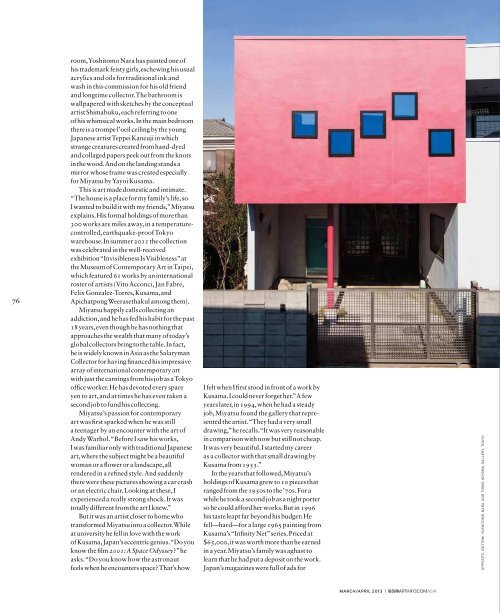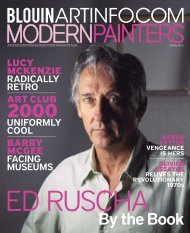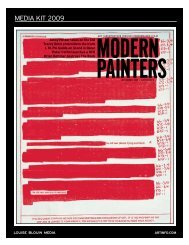Linke - Artinfo
Linke - Artinfo
Linke - Artinfo
You also want an ePaper? Increase the reach of your titles
YUMPU automatically turns print PDFs into web optimized ePapers that Google loves.
76<br />
room, Yoshitomo Nara has painted one of<br />
his trademark feisty girls, eschewing his usual<br />
acrylics and oils for traditional ink and<br />
wash in this commission for his old friend<br />
and longtime collector. The bathroom is<br />
wallpapered with sketches by the conceptual<br />
artist Shimabuku, each referring to one<br />
of his whimsical works. In the main bedroom<br />
there is a trompe l’oeil ceiling by the young<br />
Japanese artist Teppei Kaneuji in which<br />
strange creatures created from hand-dyed<br />
and collaged papers peek out from the knots<br />
in the wood. And on the landing stands a<br />
mirror whose frame was created especially<br />
for Miyatsu by Yayoi Kusama.<br />
This is art made domestic and intimate.<br />
“The house is a place for my family’s life, so<br />
I wanted to build it with my friends,” Miyatsu<br />
explains. His formal holdings of more than<br />
300 works are miles away, in a temperaturecontrolled,<br />
earthquake-proof Tokyo<br />
warehouse. In summer 2011 the collection<br />
was celebrated in the well-received<br />
exhibition “Invisibleness Is Visibleness” at<br />
the Museum of Contemporary Art in Taipei,<br />
which featured 61 works by an international<br />
roster of artists (Vito Acconci, Jan Fabre,<br />
Felix Gonzalez-Torres, Kusama, and<br />
Apichatpong Weerasethakul among them).<br />
Miyatsu happily calls collecting an<br />
addiction, and he has fed his habit for the past<br />
18 years, even though he has nothing that<br />
approaches the wealth that many of today’s<br />
global collectors bring to the table. In fact,<br />
he is widely known in Asia as the Salaryman<br />
Collector for having financed his impressive<br />
array of international contemporary art<br />
with just the earnings from his job as a Tokyo<br />
office worker. He has devoted every spare<br />
yen to art, and at times he has even taken a<br />
second job to fund his collecting.<br />
Miyatsu’s passion for contemporary<br />
art was first sparked when he was still<br />
a teenager by an encounter with the art of<br />
Andy Warhol. “Before I saw his works,<br />
I was familiar only with traditional Japanese<br />
art, where the subject might be a beautiful<br />
woman or a flower or a landscape, all<br />
rendered in a refined style. And suddenly<br />
there were these pictures showing a car crash<br />
or an electric chair. Looking at these, I<br />
experienced a really strong shock. It was<br />
totally different from the art I knew.”<br />
But it was an artist closer to home who<br />
transformed Miyatsu into a collector. While<br />
at university he fell in love with the work<br />
of Kusama, Japan’s eccentric genius. “Do you<br />
know the film 2001: A Space Odyssey?” he<br />
asks. “Do you know how the astronaut<br />
feels when he encounters space? That’s how<br />
I felt when I first stood in front of a work by<br />
Kusama. I could never forget her.” A few<br />
years later, in 1994, when he had a steady<br />
job, Miyatsu found the gallery that represented<br />
the artist. “They had a very small<br />
drawing,” he recalls. “It was very reasonable<br />
in comparison with now but still not cheap.<br />
It was very beautiful. I started my career<br />
toKYo<br />
as a collector with that small drawing by<br />
Kusama from 1953.”<br />
GallerY,<br />
In the years that followed, Miyatsu’s<br />
KoYama<br />
holdings of Kusama grew to 10 pieces that<br />
ranged from the 1950s to the ’70s. For a<br />
tomio<br />
while he took a second job as a night porter<br />
aNd<br />
so he could afford her works. But in 1996<br />
Nara<br />
his taste leapt far beyond his budget: He<br />
fell—hard—for a large 1965 painting from<br />
Kusama’s “Infinity Net” series. Priced at<br />
Yoshitomo<br />
$65,000, it was worth more than he earned<br />
in a year. Miyatsu’s family was aghast to<br />
bottom:<br />
learn that he had put a deposit on the work.<br />
Japan’s magazines were full of ads for opposite,<br />
March/april 2013 | Blouin<strong>Artinfo</strong>.comAsiA<br />
Blouin<strong>Artinfo</strong>.comAsiA | JANUARY/FEBRUARY 2013<br />
The interior of the<br />
Miyatsu home, where art<br />
is not so much installed<br />
as incorporated. From<br />
top: silkscreened<br />
wallpaper in the bathroom<br />
by Shimabuku, 2001;<br />
a trompe l’oeil collage,<br />
Muddy Stream from<br />
a Mug, 2009, by Teppei<br />
Kaneuji, on the bedroom<br />
ceiling, which also features<br />
a light fixture by the<br />
mid-century Danish<br />
designer Verner Panton;<br />
and Fusuma of HEY HO<br />
LET’S GO !, 2011, rendered<br />
in ink and wash on a<br />
sliding screen by Yoshitomo<br />
Nara. Opposite: The<br />
exterior of the Miyatsu<br />
home, designed by<br />
Dominique Gonzalez-<br />
Foerster. Construction<br />
of the house began<br />
in 1999, and is ongoing.
















